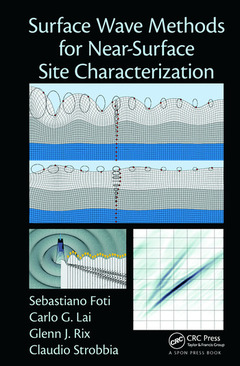Surface Wave Methods for Near-Surface Site Characterization
Auteurs : Foti Sebastiano, Lai Carlo, Rix Glenn J., Strobbia Claudio

Develop a Greater Understanding of How and Why Surface Wave Testing Works
Using examples and case studies directly drawn from the authors? experience, Surface Wave Methods for Near-Surface Site Characterization addresses both the experimental and theoretical aspects of surface wave propagation in both forward and inverse modeling. This book accents the key facets associated with surface wave testing for near-surface site characterization. It clearly outlines the basic principles, the theoretical framework and the practical implementation of surface wave analysis. In addition, it also describes in detail the equipment and measuring devices, acquisition techniques, signal processing, forward and inverse modeling theories, and testing protocols that form the basis of modern surface wave techniques.
Review Examples of Typical Applications for This Geophysical Technique
Divided into eight chapters, the book explains surface wave testing principles from data measurement to interpretation. It effectively integrates several examples and case studies illustrating how different ground conditions and geological settings may influence the interpretation of data measurements. The authors accurately describe each phase of testing in addition to the guidelines for correctly performing and interpreting results. They present variants of the test within a consistent framework to facilitate comparisons, and include an in-depth discussion of the uncertainties arising at each stage of surface wave testing.
- Provides a comprehensive and in-depth treatment of all the steps involved in surface wave testing
- Discusses surface wave methods and their applications in various geotechnical conditions and geological settings
- Explains how surface wave measurements can be used to estimate both stiffness and dissipative properties of the ground
- Addresses the issue of uncertainty, which is often an overlooked problem in surface wave testing
- Includes examples with comparative analysis using different processing techniques and inversion algorithms
- Outlines advanced applications of surface wave testing such as joint inversion, underwater investigation, and Love wave analysis
Written for geotechnical engineers, engineering seismologists, geophysicists, and researchers, Surface Wave Methods for Near-Surface Site Characterization offers practical guidance, and presents a thorough understanding of the basic concepts.
Overview of surface wave methods. Linear wave propagation in vertically inhomogeneous continua. Measurement of surface waves. Dispersion analysis. Attenuation analysis. Inversion. Case histories. Advanced surface wave methods. References. Index.
Dr. Sebastiano Foti is an associate professor in geotechnical engineering at the Politecnico di Torino, Italy. He has been a research scholar at the Georgia Institute of Technology and a research associate at the University of Western Australia, Perth. His primary interests are in geophysical methods for geotechnical characterization, geotechnical earthquake engineering, and soil–structure interaction.
Dr. Carlo G. Lai
is an associate professor in geotechnical engineering at the University of Pavia, Italy. He is also the head of the Geotechnical Earthquake Engineering Section at EUCENTRE and affiliate faculty at the ROSE School both in Pavia. His primary interests are in modeling of seismic wave propagation in geomaterials, earthquake geotechnics, and engineering seismology.Dr. Glenn J. Rix
is a principal with Geosyntec Consultants Inc. in Atlanta, Georgia (USA). Prior to joining Geosyntec in 2013, Dr. Rix was a professor in the School of Civil and Environmental Engineering at the Georgia Institute of Technology. His primary interests are in soil dynamics, geotechnical earthquake engineering, and seismic hazard and risk analysis.Dr. Claudio Strobbia
is a land processing specialist and seismic processing supervisor with Total in Pau, France. Before joining Total, he was a senior research geophysicist with Schlumberger, stationed in both Cairo, Egypt, and London. He has worked as a researcher for the EUCENTRE in Pavia, and has taught exploration seismology at the University of Milan Bicocca. His primary interests are in wave physics, inverse problems, near-surface geophysics, and seismic processing. Within exploration seismology his main contributions are in noise attenuationand near-surface characterization.Date de parution : 03-2017
15.6x23.4 cm
Date de parution : 08-2014
Ouvrage de 467 p.
15.6x23.4 cm
Thèmes de Surface Wave Methods for Near-Surface Site Characterization :
Mots-clés :
Surface Wave; Dispersion Curves; soil testing; Experimental Dispersion Curve; seismology; Surface Wave Testing; soil liquefaction; Shear Wave Velocity Profile; signal processing; Rayleigh Wave; engineering seismology; Shear Wave Velocity; geophysics; Surface Wave Data; inverse theory; Joint Inversion; Love Waves; Material Damping Ratio; Phase Velocity; Parameter Identification Problem; Wave Propagation; Surface Wave Methods; Scholte Waves; Nonlinear Inverse Problems; Homogeneous Half Space; Frequency Wavenumber Spectrum; Linear Inverse Problem; Inverse Problem; Attenuation Curves; Ordinary Differential Equations; Linear Viscoelastic; Incoherent Noise



